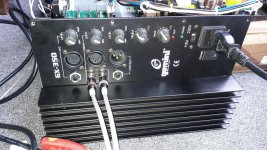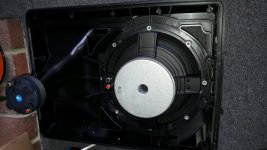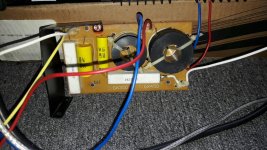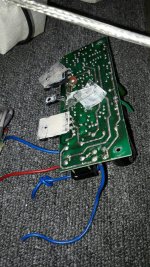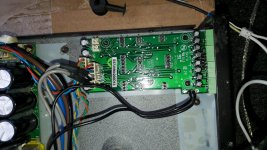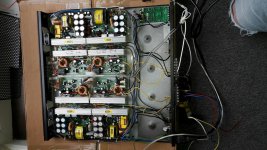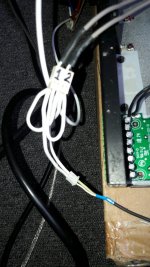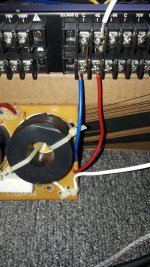Hello 🙂
I wonder if someone may be able to help me?
I have two broken items, one active PA speaker and one 4ch power amp, and want to make one working out of the two, and yes I believe they are somewhat different items but I am thinking it could work.
I have one Gemini GT-350, active speaker, and one Australian Monitor 200w/ch bridgeable 4ch class D power amp.
The Gemini, blew its fuse, I found one loose wire in side so re soldered it, still, blew the fuse, I removed and tried to test the power transistors, but only having a multimeter, I got confused, so ordered two replacement new ones, soldered these in and fuse still blows, so I removed the amp board from the Gemini, and fuse stays good.
I then remembered the AMonitor 4ch amp in the loft, I could use the power amp modules of this but, it distorts on all 4 channels, So I removed the input boards, assuming the fault affecting all 4 power amp modules would be on the input boards.
The pre, mixing part of the Gemini, which was wired to the Gemini amp board, I wired to the inputs of two of the amp modules of the AM power amp, bypassing the AM input boards.
Soak tested quietly for 4 hours, no distortion 🙂
The AM 4 ch amp could be bridged so running stereo 400w/ch rather than 4ch at 200w each. However this bridging option was switchable on the input boards that are now removed.
I am wondering if I can invert the signal from the Gemini so I can run, a pair of power amp channels, non inverted into one power amp ch1 and inverted into the ch2, and wire the XO to the +ve of ch1 and the +ve of ch2 to get the ch1 & 2 bridged. This is how the AM amp was set up, ch1 and ch2 could be bridged and wire from the +ves to the speaker, but that option as gone as the input/switchable boards are now gone.
I have done a little reading and thinking that maybe a:
http://www.samsontech.com/site_media/support/manuals/MCD2Pro_OM_5L_v2.pdf
would work with what I am trying to do, one input signal, would give two balanced signals out, which I can split, two pairs of non inverted and inverted... use these signals to bridge the 2 pairs of amps so one pair bridged for hi, and one for lo freq's
Crazy or possible?
Hope I am making some sort of sense...!?
Thanks for reading
🙂
Fingers crossed I am along sort of the right lines to get things up and running...
Yes my electronic skills and knowledge need some work!
🙂 Cheers
I wonder if someone may be able to help me?
I have two broken items, one active PA speaker and one 4ch power amp, and want to make one working out of the two, and yes I believe they are somewhat different items but I am thinking it could work.
I have one Gemini GT-350, active speaker, and one Australian Monitor 200w/ch bridgeable 4ch class D power amp.
The Gemini, blew its fuse, I found one loose wire in side so re soldered it, still, blew the fuse, I removed and tried to test the power transistors, but only having a multimeter, I got confused, so ordered two replacement new ones, soldered these in and fuse still blows, so I removed the amp board from the Gemini, and fuse stays good.
I then remembered the AMonitor 4ch amp in the loft, I could use the power amp modules of this but, it distorts on all 4 channels, So I removed the input boards, assuming the fault affecting all 4 power amp modules would be on the input boards.
The pre, mixing part of the Gemini, which was wired to the Gemini amp board, I wired to the inputs of two of the amp modules of the AM power amp, bypassing the AM input boards.
Soak tested quietly for 4 hours, no distortion 🙂
The AM 4 ch amp could be bridged so running stereo 400w/ch rather than 4ch at 200w each. However this bridging option was switchable on the input boards that are now removed.
I am wondering if I can invert the signal from the Gemini so I can run, a pair of power amp channels, non inverted into one power amp ch1 and inverted into the ch2, and wire the XO to the +ve of ch1 and the +ve of ch2 to get the ch1 & 2 bridged. This is how the AM amp was set up, ch1 and ch2 could be bridged and wire from the +ves to the speaker, but that option as gone as the input/switchable boards are now gone.
I have done a little reading and thinking that maybe a:
http://www.samsontech.com/site_media/support/manuals/MCD2Pro_OM_5L_v2.pdf
would work with what I am trying to do, one input signal, would give two balanced signals out, which I can split, two pairs of non inverted and inverted... use these signals to bridge the 2 pairs of amps so one pair bridged for hi, and one for lo freq's
Crazy or possible?
Hope I am making some sort of sense...!?
Thanks for reading
🙂
Fingers crossed I am along sort of the right lines to get things up and running...
Yes my electronic skills and knowledge need some work!
🙂 Cheers
Your idea can work and you wouldn't be the first one to remove the amp module from a powered speaker and use an external amp with it.
Are you sure that 4ch power amp doesn't alreay have the functionality to bridge a pair of channels built-in? Can you post some more pictures of it... especially the rear panel.
The compression driver doesn't need much power... 100w would be plenty so it definitely does not need the output of a bridged pair.
How much power did the Gemini plate amp generate? If you just want it functional simply use a pair of channels to power it, in reality the difference between 200w and 400w is only 3dB which may only be just noticable, and that is assuming the woofer can handle more power.
Are you sure that 4ch power amp doesn't alreay have the functionality to bridge a pair of channels built-in? Can you post some more pictures of it... especially the rear panel.
The compression driver doesn't need much power... 100w would be plenty so it definitely does not need the output of a bridged pair.
How much power did the Gemini plate amp generate? If you just want it functional simply use a pair of channels to power it, in reality the difference between 200w and 400w is only 3dB which may only be just noticable, and that is assuming the woofer can handle more power.
Gemini output, Y to ch1 and ch2 of power amp, then to Gemini XO, bi amped
DO NOT do this, you are effectively shorting two channels of the amplifier which will end badly. To use separate amp channels to power this speaker you have to either wire the drivers directly to the amp outputs and install a line level active crossover before the amp(best performing option), or use 2 completely separate passive filters in the speaker. The existence of a passive crossover in the Gemini means it only had one amp channel to begin with, so you cannot use this part to bi-amp it.
Last edited:
Your idea can work and you wouldn't be the first one to remove the amp module from a powered speaker and use an external amp with it.
Are you sure that 4ch power amp doesn't alreay have the functionality to bridge a pair of channels built-in? Can you post some more pictures of it... especially the rear panel.
The compression driver doesn't need much power... 100w would be plenty so it definitely does not need the output of a bridged pair.
How much power did the Gemini plate amp generate? If you just want it functional simply use a pair of channels to power it, in reality the difference between 200w and 400w is only 3dB which may only be just noticable, and that is assuming the woofer can handle more power.
Yes it used to have the capability of bridging, but those switches were on the input board that caused the distortion, over all channels which is now binned, hence the question...am I thinking along the right lines on how to replace the now missing bridging part 🙂
I think the Gemini used to output about 350w, so giving the bass 400 and the top 400 should give it plenty of air to breath :-o
I worked out a while ago even on 100w speakers, playing quietly, they sounded much better having 400W supply than the usual 100w...??? might just be my ears :-o
thanks for your reply!
DO NOT do this, you are effectively shorting two channels of the amplifier which will end badly. To use separate amp channels to power this speaker you have to either wire the drivers directly to the amp outputs and install a line level active crossover before the amp(best performing option), or use 2 completely separate passive filters in the speaker. The existence of a passive crossover in the Gemini means it only had one amp channel to begin with, so you cannot use this part to bi-amp it.
Ah ha... already done it ;-) Thanks for noticing though..!!
On the crossover circuit board, I separated out the supply for the top and bottom, the new additional white wire coming out the big white resistor is for the top and the original red is now just for the lo.
Yes would agree active XO would be much much better, but I don't have a spare one kicking around at the moment, and as you may guess this is bit of a budget play :-D
Oh Actually I do... but it has noisy fans, hmmm interesting possible tinkering for the future so long as I don't mess things up with bridging!
Hmm the wiring for the bridging... could I double check what I am thinking is right before I get the inverting box! I don't want to be tempted to try it, as I may have it wrong... :-o
So, single hot(non inverted) with ground, from the Gemini input mixing boards that used to go to the single Gemini amp board, will now go into the unbalanced TO balanced 2ch box, and out will come two XLR plugs with balanced signals, hot(non inverted) cold(inverted) and ground, left and right or 1 and 2 as all mono.
Going into the amp, which now has no bridging option, so needs to be done manually:
Ch1 hot with ground
ch2 cold with shared ground with 1
these two amps can then out put on ch1 speaker + and ch2 + nothing connected to speaker output -ve's
same with amps 3 and 4
ch3 hot with ground
ch4 cold with shared ground with 3
output speaker terminals ch3 + and ch4 +, nothing on the -ve speaker terminals
then back to the Gemini XO hi (ch1 & 2 from the amp) and XO lo (ch3 &4 from the amp)
and all should go will with not too much volume 🙂 ....yes?
Ummm I guess to keep things in phase... ch1 would be taken as + driver connection and ch2 would be taken as -ve driver connection?
ch3 as +ve driver connection and ch4 as -ve driver connection.
Thanks for your replies🙂 🙂🙂
I was really surprised to see how small the amp board was in the Gemini, after purchasing a fair few hi fi amps over the years and they are massive ... well the boxes are! compared to the dinky Gemini v.powerful tiny board!
Interesting 🙂
So, single hot(non inverted) with ground, from the Gemini input mixing boards that used to go to the single Gemini amp board, will now go into the unbalanced TO balanced 2ch box, and out will come two XLR plugs with balanced signals, hot(non inverted) cold(inverted) and ground, left and right or 1 and 2 as all mono.
Going into the amp, which now has no bridging option, so needs to be done manually:
Ch1 hot with ground
ch2 cold with shared ground with 1
these two amps can then out put on ch1 speaker + and ch2 + nothing connected to speaker output -ve's
same with amps 3 and 4
ch3 hot with ground
ch4 cold with shared ground with 3
output speaker terminals ch3 + and ch4 +, nothing on the -ve speaker terminals
then back to the Gemini XO hi (ch1 & 2 from the amp) and XO lo (ch3 &4 from the amp)
and all should go will with not too much volume 🙂 ....yes?
Ummm I guess to keep things in phase... ch1 would be taken as + driver connection and ch2 would be taken as -ve driver connection?
ch3 as +ve driver connection and ch4 as -ve driver connection.
Thanks for your replies🙂 🙂🙂
I was really surprised to see how small the amp board was in the Gemini, after purchasing a fair few hi fi amps over the years and they are massive ... well the boxes are! compared to the dinky Gemini v.powerful tiny board!
Interesting 🙂
Last edited:
Just realised... the XO at the moment while using bi-amping, is fine with separate hi input and separate lo input... and they share the output (ground)...
I shall need to separate the XO totally yes? with no shared output, as common ground is not used any more in bridging... hmm
Interesting little project!
I shall need to separate the XO totally yes? with no shared output, as common ground is not used any more in bridging... hmm
Interesting little project!
Yes keep the passive crossovers completely separate from one another. And don't bother with bridging the amps for the tweeter, it only needs about 1/10th the power the woofer gets to produce the same sound level.
Cool Thank you!! Passive crossover separated out, all bits back together, plugged in and working... :-D
However things are very quiet... I am guessing this is due to the fact the DI box is passive, and has split the signal. So if the two pairs of the 4 channels are bridged, there are 4 outputs made from one input, so I guess 1/4 of the volume... hmmm....
might there be a box out there to get these signals back up to normal levels... yeah I know its getting a bit complicated now. But interesting learning!
However things are very quiet... I am guessing this is due to the fact the DI box is passive, and has split the signal. So if the two pairs of the 4 channels are bridged, there are 4 outputs made from one input, so I guess 1/4 of the volume... hmmm....
might there be a box out there to get these signals back up to normal levels... yeah I know its getting a bit complicated now. But interesting learning!
- Home
- Live Sound
- PA Systems
- Frankenstein Speaker - one good made from broken bits, bridging!?
